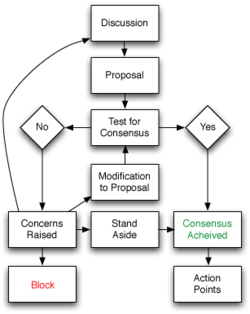
This is the second of three posts aimed at helping groups like Save Our Water Rights (see earlier posts) make the best case they can for their issues. Our system of government works best when everyone is able to do this. As in life, if we do our best we either get what we want or else we can at least know that we did our best if we don't get what we want.
As with the earlier post, about organizing meetings, I'm not referring to anything specific about SOWR's meeting last night, but just talking generally about what I have found to work in the many meetings I have organized and run. Running meetings can be hard, and takes practice. Some people seem to be better at it than others.
There are lots of ways to run meetings and to make decisions. What I have in mind here is a situation like SOWR's, where a group is forming, choosing goals, and planning activities. It's important to build a sense of teamwork and cohesiveness, especially if members of the group don't know each other. These comments are meant for informal, citizen/volunteer-type groups, obviously, not official/government meetings, although there is some overlap.
1. It's best to have a written agenda, with enough copies for everyone. Ideally, the agenda will have been sent out ahead of time.
2. If the group is small enough, everyone can sit around a table; slightly larger groups should sit in a circle. Make sure everyone can hear and see one another. Pass around a sign-up sheet to collect contact information.
3. If the group is not too large, go around the table or the circle and have everyone introduce themselves. The leader might make notes during this process, so s/he can call on people by name during the meeting.
4. Usually, making decisions by consensus is best, at least at first. This means a decision gets discussed and tweaked until everyone can agree with it. Everyone should have a chance to comment, and anyone who has concerns should be listened to respectfully and the concerns dealt with. Watch out for some of the problems with consensus, all of which I have seen. It takes practice to deal with or avoid the problems.
5. The group should have only one discussion at a time, not several conversations at once.
6. The leader of the discussion should keep the group on topic and try to make sure everyone is able to participate. Keep in mind that the goal is to get something done, so make a list of action items for each agenda item, as appropriate. Make a note of who will do each thing, and put these details into the notes from the meeting.
7. Someone should take notes during the meeting. I usually try to do this by writing on the agenda, or another member of the group can act as secretary. As soon as possible after the meeting, preferably the same day, the notes should be typed up and sent to everyone.

No comments:
Post a Comment